"The Financial Market Crisis and Risks for Latin America" - Presentation by Anoop Singh,, Director, Western Hemisphere Department, IMF
March 18, 2008
Director, Western Hemisphere Department, IMF
At the Conference on "The Euro: Global Implications and Relevance for Latin America"
Sao Paulo, Brazil, March 17, 2008
1. Over the past four years, Latin America has generally done well in taking advantage of a very favorable global environment to strengthen policy frameworks and lower long-standing vulnerabilities. However, the external environment has abruptly changed, led by mutually reinforcing financial sector shocks in the United States, that are spilling over into the global economy. Thus far, our baseline forecasts show Latin American growth holding up pretty well. However, how robust is the region to the exceptional downside risks that still affect the U.S. and global outlook? To address this question, we need to look closely at the various elements of the downside risks facing the world today and what they could portend for emerging markets in general and Latin America in particular.
I. The U.S. Outlook-Downside Risks
2. This is clearly a period of exceptional uncertainty. The distribution of risks for the U.S. outlook is wide and skewed clearly toward the downside, and the probability of additional shocks leading to a U.S. recession, is quite high (Figure 1 and Table 1). There are at least three broad factors that could potentially reinforce each other and derail consumption—the mainstay of the U.S. economy—pushing growth into the negative tail of the distribution:
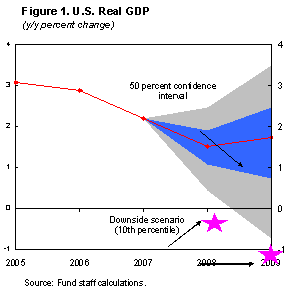
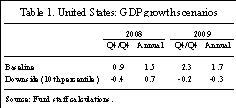
• Housing. This has been ground zero for the current financial market turmoil. An asset price bubble is in the process of deflating, and it is difficult to know how far the process will have to go before it bottoms out (Figure 2). We know from past experiences that output effects from housing price busts last about twice as long as those from, say, a bursting equity price bubble.1 Thus, we are almost certainly looking at a protracted process. Indeed, there is now nearly ten months' supply of new houses for sale—the highest since 1981—and with rising foreclosures putting more houses back on the market, it will take quite some time—and substantial price declines—before the situation normalizes. In such a market the decline in housing prices could very well turn out much worse than in our baseline forecast (that has average housing prices falling by some 15 percent over the next two years), given the still large gap in their historical relation with disposable income.
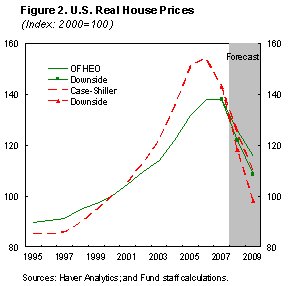
There are various elements that are not yet clear. First, loans made in 2006 and 2007—the riskiest—are only now undergoing rate resets and, although delinquency rates have risen sharply, their full force has probably yet to be felt (Figure 3). Second, widening spreads on mortgages have meant that the monetary easing that began last year has not translated into substantially lower rates on consumer loans and mortgages, largely due to the weakening position of banks (Figure 4).
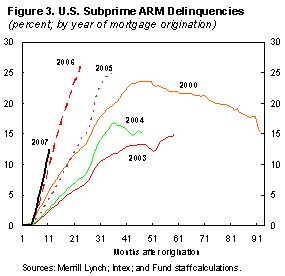
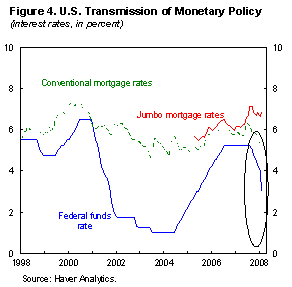
Third, there are emerging indicators that the problems in U.S. housing are starting to spread beyond subprime to other segments of the real estate market. For example, foreclosure rates on prime mortgages have recently started to increase. Finally, there is a concern that similar housing price increases abroad—many of which have been larger than in the United States—might deflate abruptly, with potential financial feedback effects (Figure 5).
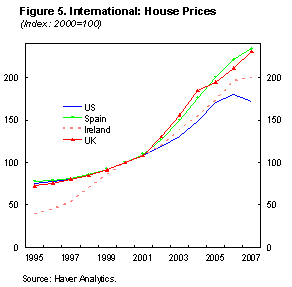
• Strains in the core financial system. The ongoing process of adjustment in capital markets has led the large financial institutions in the United States to absorb onto their balance sheets sizeable losses from off-balance sheet entities, securitized special investment vehicles, asset-backed commercial paper, and other innovative financial products with a resulting downgrade in the perceived strength of these banks (as captured by credit default swap rates, Figure 6).
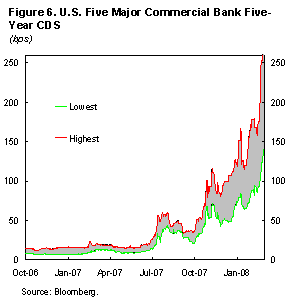
To cope with the assumption of these losses, banks have started raising capital, including through infusions from sovereign wealth funds. This is positive. However, as with the housing market, many uncertainties remain. The size of bank losses remains extremely difficult to assess. At this point, preliminary estimates suggest that banks' subprime-related losses to mount further to around US$230 billion worldwide, with about half of that amount residing in the U.S. banking system and the remainder mostly in Europe. An additional US$100 billion or so in losses may also arise from bank holdings of other financial assets (including commercial mortgages, leveraged loans, credit card debts, and others). However, losses could mount much further as an economic downturn brings with it a widening deterioration of credit across a broad range of household and corporate credit. In an adverse scenario, bank losses could be much larger, putting pressure on the capital position of some of the main global banks and forcing them to curb credit growth and shore up capital. This would restrict credit availability to both household and corporate sectors and further disrupt the economic recovery. Indeed, there is already evidence that such a deleveraging process is underway with banks reporting a substantial tightening of lending standards (Figure 7).
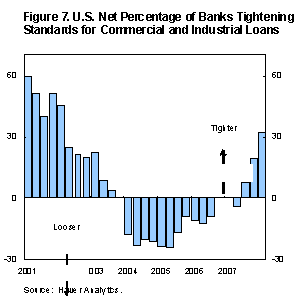
Outside of the banking system, a broader global deleveraging process could also unfold with asset price declines triggering margin calls on hedge funds and other leveraged investors, as we have seen in recent days, and forcing asset sales and greater asset price declines. This, when combined with weakening bank balance sheets, could lead banks to raise margin requirements, fueling an already volatile mix.
• Contagion to other markets. Contagion to other credit markets and nonbanks in the United States and Europe in particular is another key risk in the downside scenario and would have mutually reinforcing effects on a weakening economy. Beyond the subprime-related losses mentioned above, losses are likely on other asset classes, such as commercial mortgage-backed securities, high-yield corporate debt, collateralized loan obligations (CLOs), and a variety of unsecuritized loan types. All in all, a range of estimates from a number of sources place possible losses that the global financial system could be facing at close to $800 billion spread across banks, insurance companies, hedge funds, and pension funds (a little over one-half of which resides in U.S. institutions), although some analysts are projecting much higher losses. As a share of GDP, such losses are already at a level similar to those seen during the U.S. Savings and Loan episode (Figure 8). This would have direct implications for credit extension and for growth outcomes, which could, in turn, drive asset values further downward and impose more losses on the financial system.
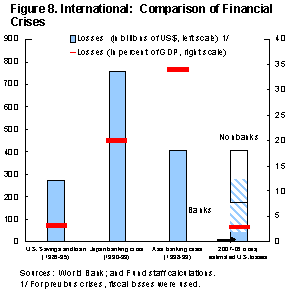
3. To summarize, were these combined additional shocks to housing, the core financial system, and other credit markets to materialize, they would affect the wider U.S. and global economic situation by curtailing the availability of credit and intensifying the negative wealth effect on households. Although aggregate data suggest that corporate balance sheets are resilient, we have seen similar credit indiscipline in the leveraged buyout and high-yield corporate bonds. Though default rates are low, they could rise quickly in a sharper U.S. slowdown and those corporations with high leverage could face significant refinancing risks. If these risk factors materialize, a credit crunch could become global, marked by rising costs of cross-border financing and reduced availability of funding. Together with slowing activity in an array of industrial countries, this would lower the demand for various emerging market exports, with a key risk being a loss of export momentum in China. Such a coordinated slowdown could create downward pressure on commodity prices—for food, fuels, and minerals—that are crucial to Latin America, reverse the capital flow into emerging market economies, and result in a considerably deeper and more protracted slowdown of global growth, well below our current baseline (Figure 9), and raising the specter of a global recession.
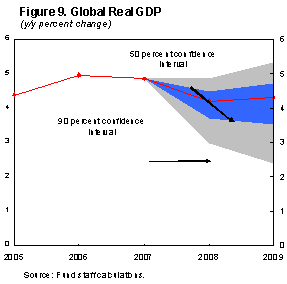
II. The Impact on Latin America
4. Our baseline scenario foresees a modest slowing of regional growth, to about 4½ percent in 2008, but there could be more serious effects if the downside risks in the global economy materialize (Figure 10). Let's examine how resilient Latin America is to the kind of shocks affecting the advanced economies, and outline some reasons why Latin America may escape recession, even with downside outcomes in the United States.
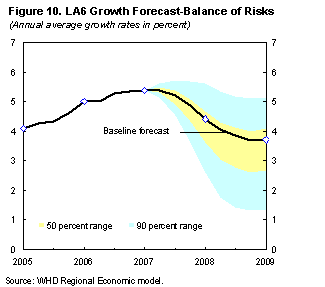
5. Asset price bubbles? Are there similar asset price bubbles that could threaten Latin America? Here the assessment is cautiously positive. No substantial exposure is reported in Latin America to the subprime-related distressed credit products that we have seen in the United States, even though the trend in some countries has been toward increased domestic securitization. It has helped that in many countries, including here in Brazil, regulatory frameworks have made it difficult for banks to either buy the kind of structured products that have been at the center of events in the United States or accumulate significant off-balance sheet exposures. Second, housing price trends do not indicate the kind of price run-up that we have seen in the United States and some European economies, although the data here is very incomplete. Against this, equities have boomed in the region, especially for commodity-linked companies, which account for a substantial share of market capitalization in Brazil, Peru, and Chile. It should help that, broadly speaking, valuations appear in line with real earnings prospects, although the performance of more commodity-dependent stock markets will depend greatly on the impact on global commodity prices if a global recession were to unfold.
6. Implications for the sovereign? Similarly, our sense is that the external environment should not put exceptional pressure on Latin American sovereigns, at least not in the near term. To be sure, spreads on Latin American sovereign debt have already risen but the increases have been much more moderate than has historically been the case, in large part due to the strong fiscal positions, improved structure of public debt, and large build-up of international reserves (Figure 11).
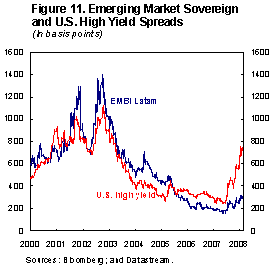
Our assessment is that further increases in global risk aversion, while raising spreads, should be manageable for many countries in the region. However, there will likely be a greater discrimination between high- and low-risk countries which may put pressure on those in the region with weaker policy frameworks. Having said this, much again will depend on commodity price developments, a subject to which I will return.
7. This time around, greater corporate stress? What are the risks that, this time, it is the corporate sector that could be disproportionately affected? On the one hand, corporations in Latin America are used to operating in an environment of macroeconomic volatility, and still rely on retained earnings for the bulk of their financing.2 Nonetheless, cross-border funding flows have grown in importance for corporates in the region, and this may open new channels of contagion. Indeed, there are already signs of some stress:
• Corporate bond financing. Spreads on Latin American corporate bonds have widened by over 200 basis points, more than the rise in spreads on sovereign bonds (Figure 12).
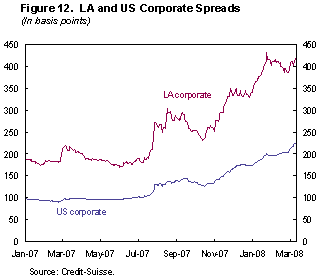
Since corporate balance sheets appear generally strong, this should have little effect on investment decisions in the short run and many corporates are in a sufficiently comfortable position that they can choose to delay issuing new debt. Indeed, we have already seen a marked decline in bond and loan issuance by Latin corporates over the last six months, and especially in the first two months of this year. As yet this does not appear to have materially curtailed investment decisions. However, if the cost of financing continues to rise and becomes more protracted, the less advantageous market for corporate credit could represent a constraint on new investments. This is particularly the case given that domestic bond markets in the region are small and do not provide an adequate alternative to external financing.
• Equity issuance. Up until the first half of 2007, strong demand for emerging market equities led to a marked increase in new equity financing by Latin corporates (Figure 13).
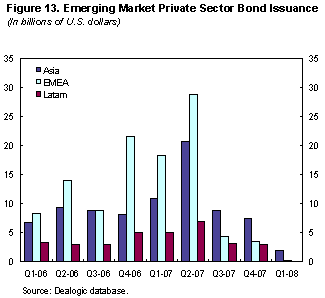
In Brazil alone, over 100 firms launched new IPOs in 2007, targeted at both local and international investors, raising US$47 billion in new capital. While Latin equity prices have fallen of late, perhaps of more concern is the sharp reduction in primary equity issuance since end-2007 (Figures 14-15).
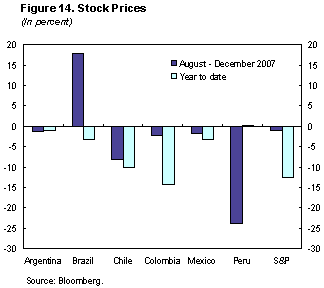
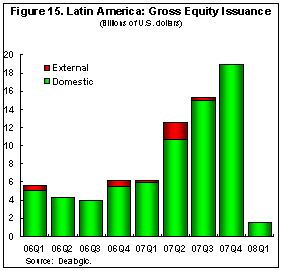
8. Risks to domestic bank credit. Although private credit growth—especially of consumer credit—has been very rapid in the region (averaging 25-35 percent), so far, this has been generally reflective of structural and regulatory improvements. Moreover, much of the funding of this growth in credit has come from domestic sources—especially from an expanding domestic deposit base—and so it has not generally mattered that access to longer-term structured loans in domestic currency, financed by offshore investors, has been curtailed. This explains why domestic currency interbank spreads, such as here in Brazil, have remained stable despite the global financial turmoil. Against this, there are some risks that need to be monitored closely. There has been an uptick of delinquency rates, especially at smaller banks in some countries. In addition, in several countries in the region, subsidiaries of global banks are an important and successful part of the local banking system. There is the risk that liquidity or capital pressures in their parent companies in the United States and Europe could lead these banks to downsize their operations or draw on the capital or liquidity resources of their subsidiaries in the region.
9. The key influence of commodities. Many countries in Latin America have benefited greatly from the commodity boom, which has helped improve the terms of trade for the region by over 10 percent since 2005, a result of strong increases in crude oil, metals, and agricultural product prices. The value of commodity exports for the region is now around 10 percent of regional GDP and accounts for over 40 percent of export revenues. This strength has bolstered regional growth, strengthened current account positions, and also been a major factor behind the increase in the fiscal surplus in many countries. Even with the baseline for the U.S. and global outlook, commodity prices should hold up well over the next year as a whole, reflecting the importance of demand from emerging economies for the near-term prospects for many commodities, as well as the combination of low interest rates and a depreciating U.S. dollar (Figure 16).
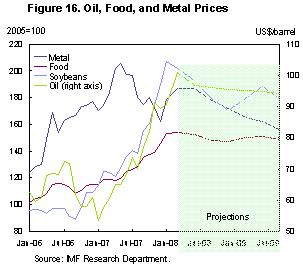
Our model-based estimates suggest that even with a U.S. recession, commodity prices may decline only modestly, especially if key emerging market countries, such as China and India, continue to grow rapidly. This said, a deep U.S. recession that triggers large output declines elsewhere in the industrial world and slows growth significantly in key emerging market countries could have a larger impact on commodity prices, as has been the case during previous global downturns (Figure 17).
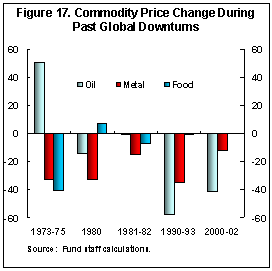
If this precipitated an unwinding of sizeable speculative positions in many of these commodities, price declines could be abrupt. Such a large drop in commodity prices would have an important impact on the region. For example, if commodity prices were to fall back to the levels seen at the end of 2005 (an average decline of 35 percent), fiscal and trade balances on average in the region would deteriorate sharply, raising financing requirements at a time of tighter global credit markets, and potentially resulting in a regional recession (Figures 18-19).
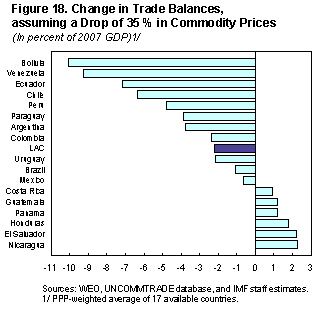
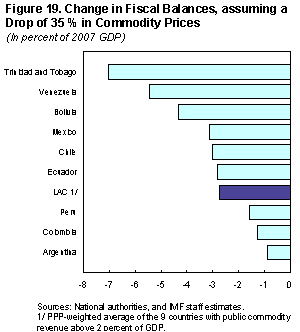
10. Where does that leave policymakers? In closing, what message should policy makers draw when thinking about the various global risks now facing Latin America? It is true that many of the aspects of a possible downside scenario are beyond the control of regional authorities. However, I would gravitate, perhaps, to four broad themes that are relevant:
• The region is now reaping the rewards from a decade of investment in reducing vulnerabilities. The investments that policymakers have made in recent years—to lower fiscal deficits, build international reserves, improve the structure of public liabilities, strengthen bank supervision and regulation, and build credibility in their monetary frameworks—are now going to show their true value. The reduction in vulnerabilities has the potential to allow Latin America to pass through our baseline scenario relatively unscathed and certainly without the major macroeconomic swings that were evident since the Tequila crisis. This should not lead to complacency but rather further convince policymakers of the importance of their achievements to date and the need to continue along the path they are currently on.
• However, the prospects for weaker commodity prices should translate into greater conservatism in public spending growth. While the fiscal position has been strong for many countries in the region, a not insignificant share of the improvement has been due, either indirectly or directly, to commodity revenues. The strong revenue performance, while in part saved, has also facilitated a rapid real rate of growth in public expenditures in the past couple of years. Policymakers should now reexamine their expenditure priorities and, in particular, look to preemptively lessen the rate of growth of current outlays, to protect the fiscal position in the event of a significant shock to world commodity markets.
• Supervisory authorities should monitor particularly carefully the situation in foreign bank subsidiaries. While supervisory authorities in many countries are clearly watching closely their own financial institutions, it would be valuable for them also to cast a wider net and enter a dialogue with their counterparts in the home countries of their main foreign bank subsidiaries. This will facilitate a greater understanding of the overall position of the banking group and also will allow supervisors in Latin America to react quickly should foreign parents start to come under greater financial stress.
• Well functioning disclosure and reporting frameworks are vital. We have seen in the industrial countries how uncertainty can have a pervasive effect on the workings of the most fundamental capital markets. Both foreign and domestic investors need to be able to see clearly the health of the region's financial institutions to make judgments about asset allocation, particularly in periods of stress. The region's policymakers should turn their attention to ensuring that reporting frameworks provide timely information and reliable valuations of financial institutions' balance sheets to better insulate the region from contagion from external confidence shocks.
1 Real and Financial Effects of Bursting Asset Price Bubbles, World Economic Outlook (IMF, April 2003).
2 A recent World Bank survey indicates internally generated funds finance over 60 percent of Latin American corporate investments and working capital (World Bank Enterprise Survey, 2006).
IMF EXTERNAL RELATIONS DEPARTMENT
| Public Affairs | Media Relations | |||
|---|---|---|---|---|
| E-mail: | publicaffairs@imf.org | E-mail: | media@imf.org | |
| Fax: | 202-623-6220 | Phone: | 202-623-7100 | |


